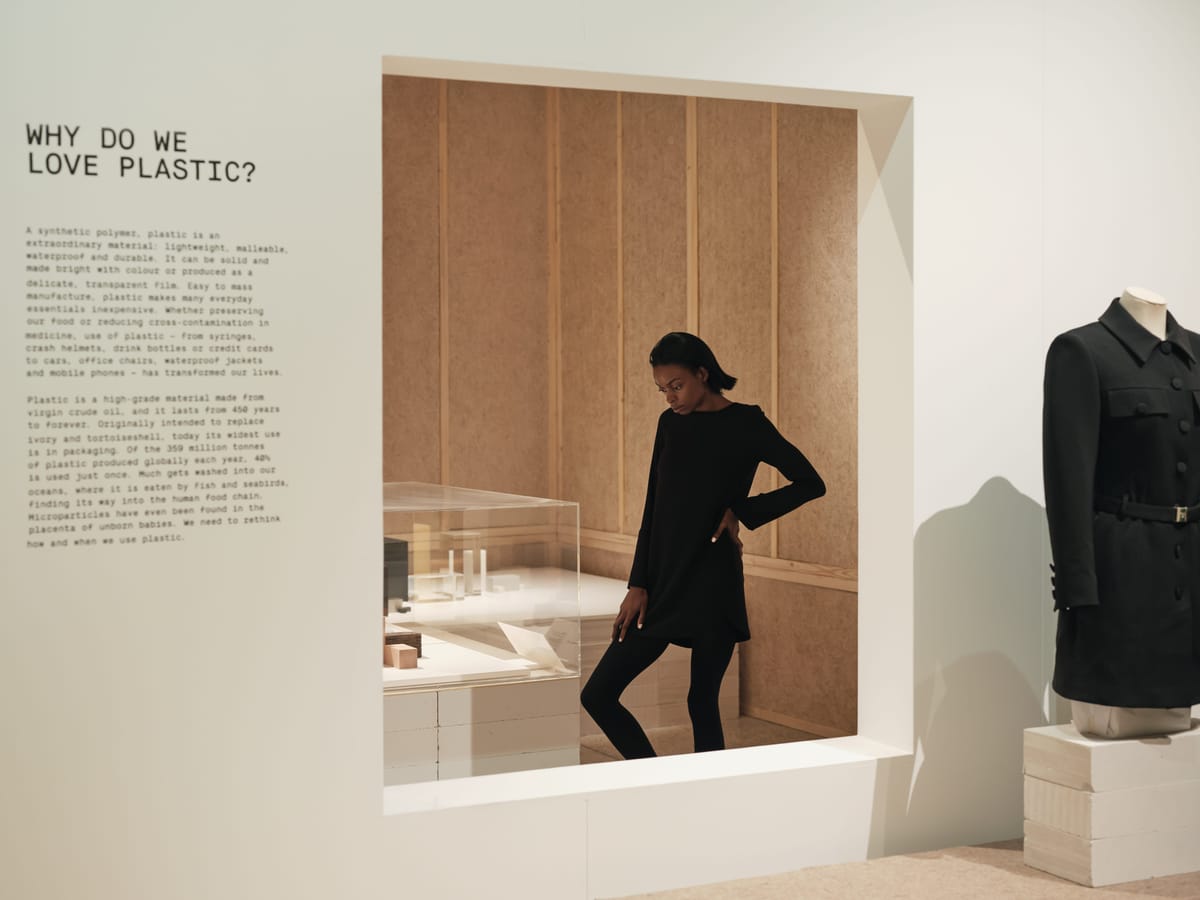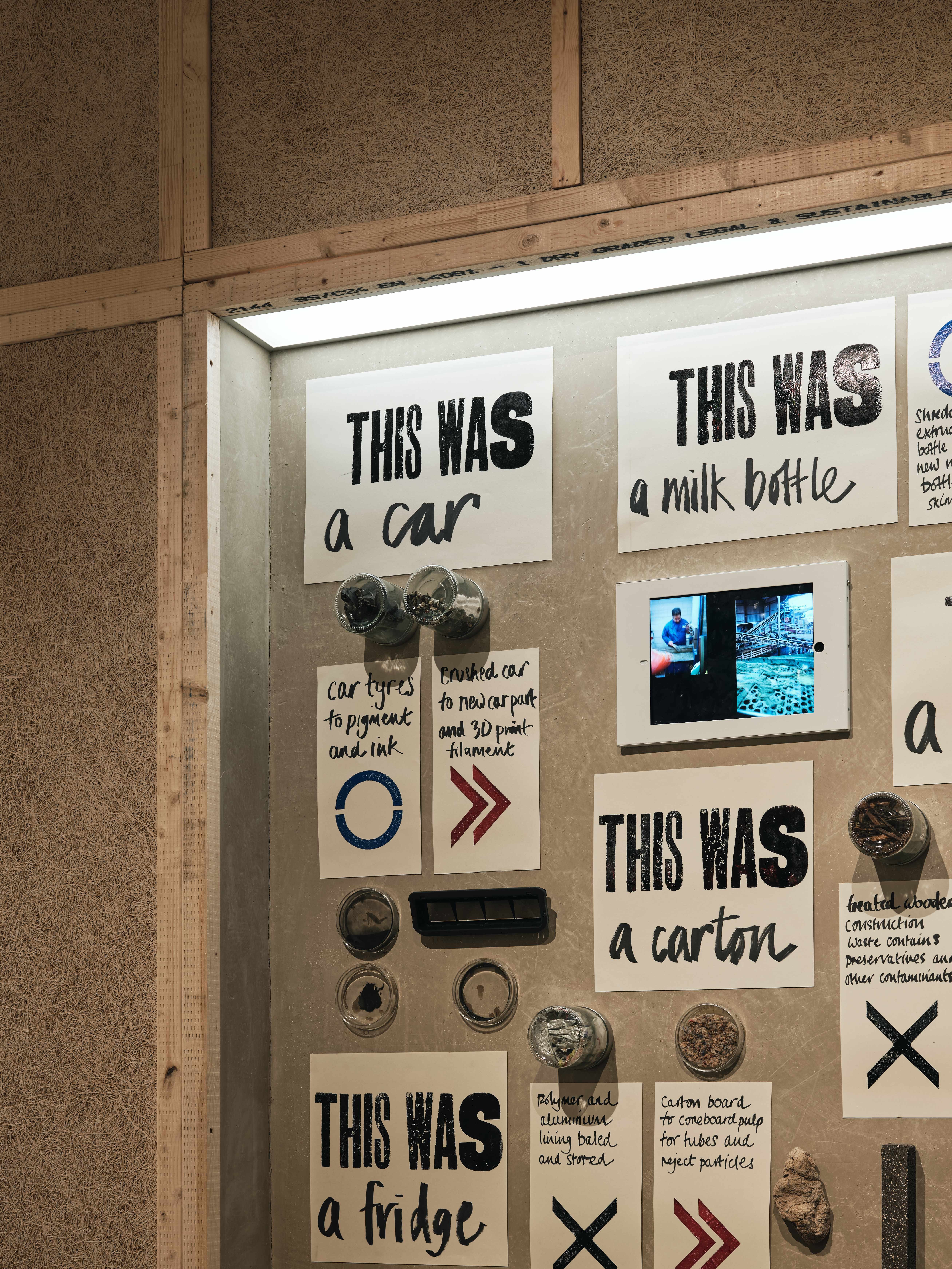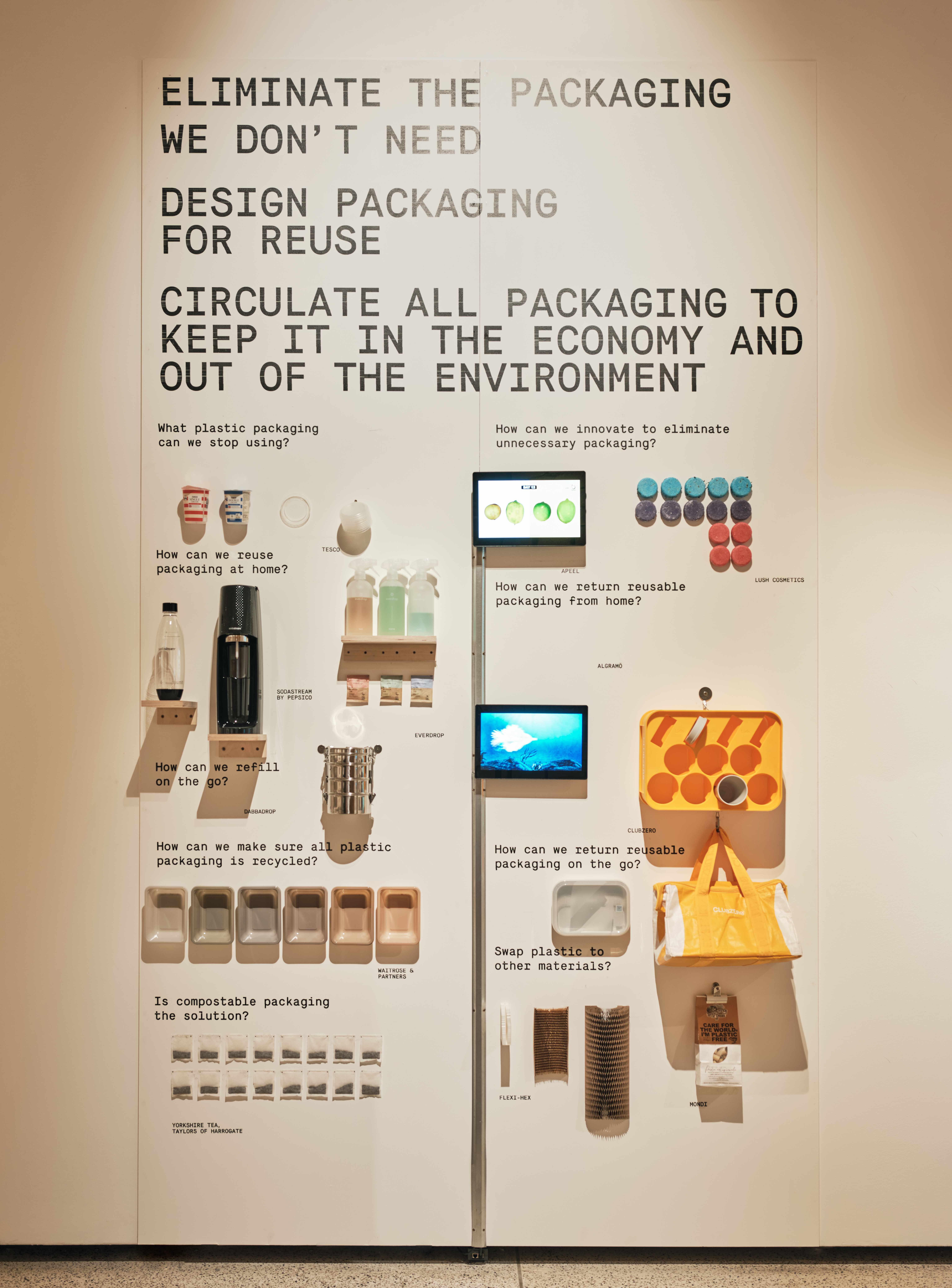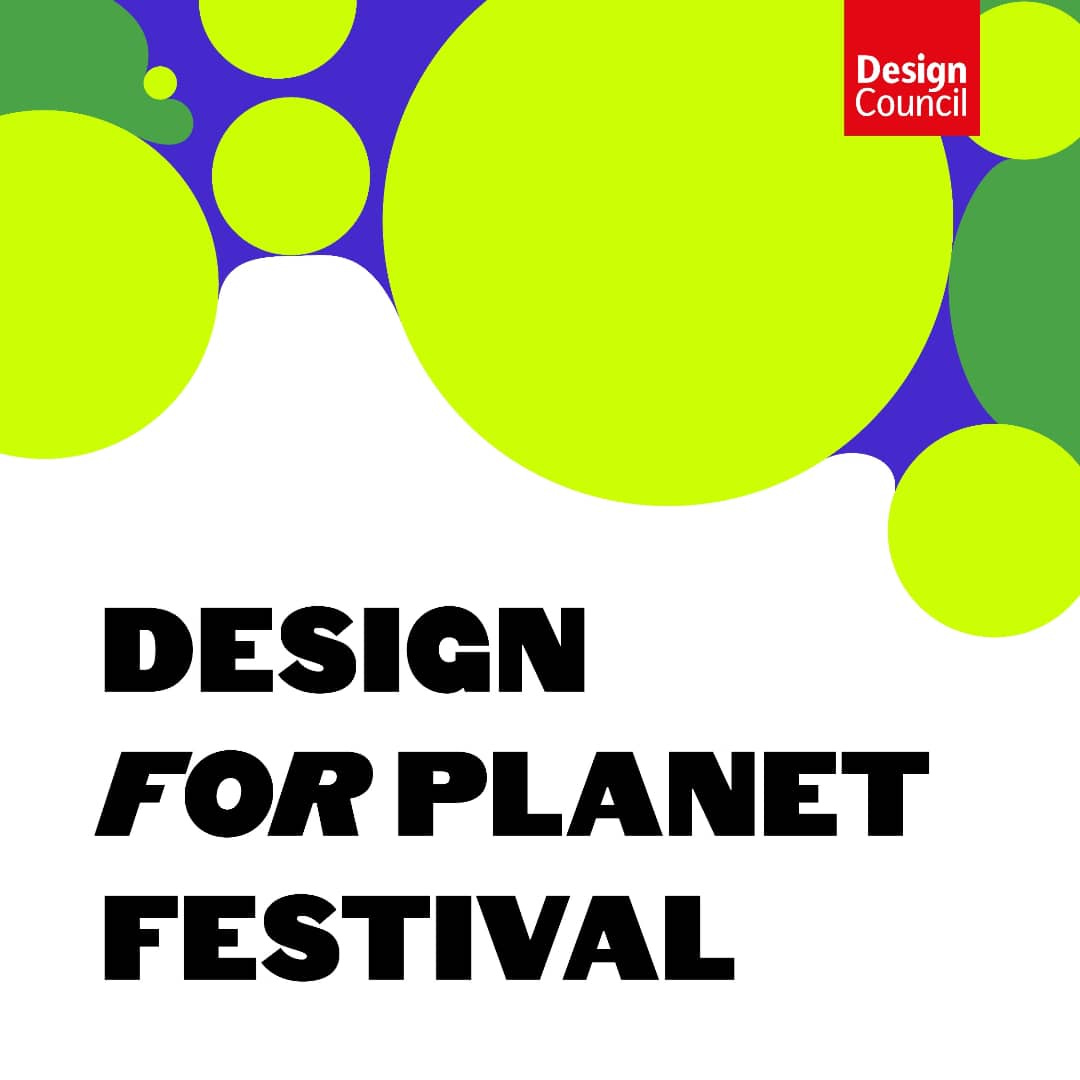
URGE Youth Assembly member Fiona Glen speaks to the collective’s Alexie Sommer and Sophie Thomas, and to independent data analyst, Ralf Waterfield, about their environmental analysis of the Design Museum’s landmark Waste Age show.
We’re in a climate emergency, and half of the change we need to make is in resource use. It’s fundamental for organisations to understand their impact, and for designers to pay attention.
—Sophie Thomas
A week before COP26 begins in Glasgow, the Design Museum has opened the doors to Waste Age. This timely exhibition highlights the environmental impact of our throwaway culture, and the designers who are responding by reimagining or eliminating waste in their work. Speaking directly to the industry, the Design Museum has a uniquely powerful platform to not only communicate a message, but explore paths for practical action. As Waste Age asks what design can do to end our era of ‘peak waste’, the production of the exhibition itself was a clear chance to show how the environmental cost of experiences – not just commodities – can be reduced. But to improve its impact, the Design Museum first needed to understand it.
Since April 2021, URGE has been carrying out an in-depth environmental audit of Waste Age, working closely with the exhibition’s curators and contributors to create a comprehensive picture of resource use, carbon emissions, and waste generation. URGE’s full audit will span three phases: before, during, and after the exhibition. For the pre-exhibition stage, Alexie Sommer, Sophie Thomas and Ralf Waterfield built their overview first-hand by interviewing key exhibition stakeholders, working with designers and suppliers to gather data, and directly observing processes from commissioning to construction.

Sophie Thomas created this materials wall for Waste Age showcasing how waste materials are recovered and processed into new materials with a wide variety of uses
Getting involved
Sophie explains how being physically present during build and while the exhibition is open is crucial for catching unintended impacts. “People’s behaviour is unpredictable. We need to take real actions into account.” Having seen how her 2019 audit of Dezeen Day picked up on unexpected impacts such as food waste, which a top-down review using industry data would have missed, the Design Museum committed to reviewing Waste Age the hard – and more accurate – way. “There’s a real appetite for deeper understanding here,” says Alexie. “Gathering data first-hand takes a lot of work,” adds Ralf. “But the insights from it will be really useful for the Museum, and they can become a resource for future exhibitions.”
Through their continuous involvement in Waste Age’s development, URGE has advised the Museum on some immediate improvements. They started the audit by building an Impact Model which maps out the exhibition’s expected footprint, allowing teams to discuss and implement changes. “We’re sharing a learning experience, helping people understand how changes they make could have knock-on effects,” says Alexie.
Digging deeper
One of URGE’s core roles is challenging assumptions about making sustainable change, which often don’t hold in practice. For example, switching from print to digital interfaces can have a major effect on the Museum’s digital carbon footprint and electricity consumption – and the teams responsible for managing them. Biodegradable materials can be more resource-intensive to produce and ship than recycled plastic, and supplier websites often don’t give designers an accurate picture of materials’ impact.
“You have to ask the next question, follow up on information, do the opposite of greenwashing,” says Sophie. “We want to help designers to use data in their work.” In complex supply chains with hidden layers, gathering complete data on resource use and carbon emissions is often difficult. “This is always the biggest challenge, especially if it’s not a priority for your suppliers,” explains Ralf. “But evidence is critical, and people are increasingly educated and interested in it.”
Translating the wealth of information URGE is collecting into useful narratives and clear examples is crucial throughout the ongoing audit. The pre-exhibition analysis reveals that some unassuming elements come at a surprisingly large environmental cost. Roughly 20% of impact so far was generated by the 4,800 standard stainless steel screws used in the exhibition build, while digital communications made up another 10%. Emails and file sharing alone accounted for up to one tonne of CO2e (CO2 equivalent).
Overall, Waste Age managed to dramatically reduce its expected impact from 185 to 10 tonnes of CO2e, with the most significant reduction coming from the Museum using renewable energy. This alone cut the exhibition’s total impact by 95%. The next greatest saving came from the 3D design approach by Material Cultures, who used walls of unfired and unfixed adobe bricks for part of the build. Compared to using only fired bricks, this solution cut emissions by roughly 6 tonnes. After Waste Age, these bricks will be easily disassembled and returned to their producer for reuse. By embedding this kind of circularity in their approach and using biodegradable materials, designers can significantly reduce the carbon footprint and afterlife impact of structures.

As part of the environmental audit on Waste Age, URGE worked with exhibition graphics designers Spin. To avoid vinyl stickering, the Spin team developed an innovative method of printing directly onto the walls using hand-held inkjet printers, which themselves use water-based ink
Nurturing change
While it has previously tracked the impact of its building with Julie’s Bicycle, the Museum aims to use the full Waste Age audit as a benchmark for all exhibitions, building on their learnings to make long-term progress. To help set this in motion, URGE is working to embed new habits and offer the Museum a clear list of questions to work through on future projects. As Ralf underlines, “We’re here to build a tool that can be applied to any exhibition. Our work can’t end up on the shelf – the audit is just the beginning.”
URGE’s full review will also chart the human impact of Waste Age through interviews, assessments and projections. By expanding the usual scope of an environmental audit to assess the exhibition’s ‘sphere of influence’, URGE will consider Waste Age’s public narratives, educational value for visitors and contributors, and ability to shift attitudes. These types of impact can grow exponentially as people act on greater awareness and spread new behaviours, Sophie explains. “The real power of a museum is to inspire, educate and engage people around the most important issues we face. That’s our hope with this contribution, too.”
Waste Age: What can design do? Is at the Design Museum, London, until February 20, 2022. Ticket details here
Exhibition photography by Felix Speller for Design Museum
Fiona Glen is a member of the first cohort of the URGE Youth Assembly. Fiona is an emerging writer and RCA graduate: discover more about her at www.fiona-glen.com and, on Instagram, @fiona_____glen
If you are interested in joining the URGE Youth Assembly, please contact us on hello@urgecollective.com

URGE is partnering with Design Council on the Design for Planet festival, galvanising the design community to address the climate emergency. The festival will be taking place on 9 & 10 November at V&A Dundee and online. Register for free tickets here

